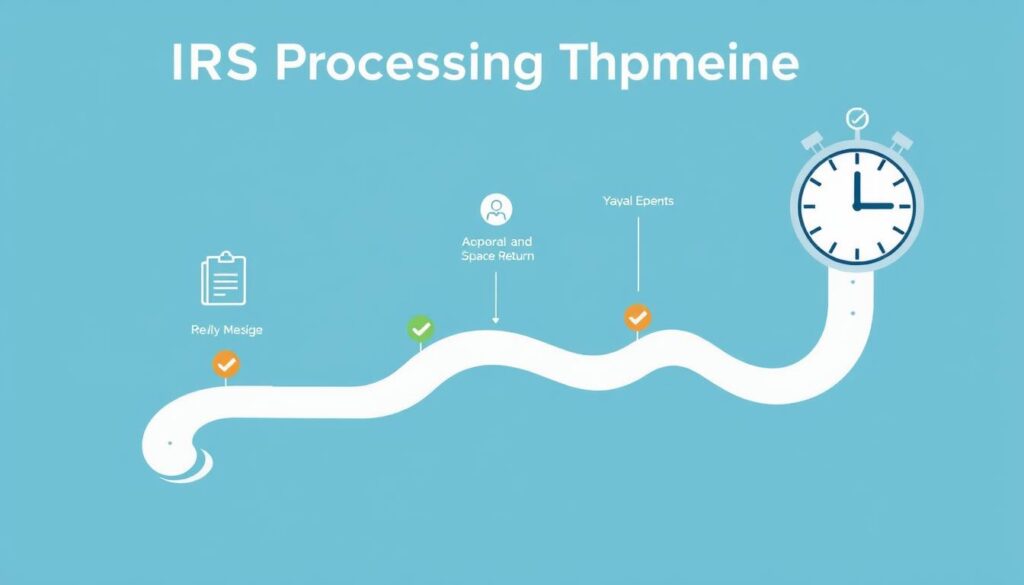Did you know that usually, only 9 in 10 tax refunds get processed in 21 days by the IRS? This fact highlights how vital it is to grasp Tax Topic 152. This is especially true if your federal tax return faces delays1. Tax Topic 152 is a key signal for taxpayers. It means their returns need more review and may take longer2. This guide will help you understand Tax Topic 152 for your refund process. Plus, we’ll give you tips to deal with IRS rules. Knowing what to do can really help if your tax return is delayed.
Let’s dive into Tax Topic 152. It’s crucial to be ready for a potential long wait.
Key Takeaways
- Tax Topic 152 indicates a review of your tax return processing by the IRS.
- On average, most refunds are processed within 21 days, but exceptions exist.
- Filing electronically and opting for direct deposit can expedite your refund.
- Common reasons for delays include errors in your return and specific claims.
- Utilize the IRS’s “Where’s My Refund?” tool to track your refund status.
What is Tax Topic 152?
Receiving a notice about Tax Topic 152 means the IRS is carefully checking your tax return. This topic doesn’t mean there are problems. It only means that processing is taking longer than the normal 21 days for e-filed returns3. This notice often pops up for taxpayers checking their tax refund status on IRS tools.
Definition and Purpose
The definition of tax topic 152 comes from IRS rules for reviewing returns. It’s a heads-up to taxpayers that their filings need a closer look. If you’ve claimed credits needing extra checks, Tax Topic 152 is likely to appear. This ensures all details are correct before sending out refunds, which may delay the process. While most returns are sorted in 21 days, certain claims or busy seasons can slow things down45.
How It Appears in IRS Tools
You can find out your tax return’s status with the IRS’s “Where’s My Refund?” tool. This site updates you about 48 hours after e-filing3. Noticing Tax Topic 152 there means your return needs more time, especially for certain credits like the Earned Income Tax Credit or the Additional Child Tax Credit. So, patience is key as this shows the IRS’s commitment to precise processing5.
Understanding the IRS Processing Timeline
Knowing the IRS processing timeline helps you know when to expect your tax refund. The IRS usually processes e-filed returns within 21 days, but paper returns take about six weeks6. The timing for tax refunds can change if there are delays in processing7.
Typical Timeframes for Refunds
Many taxpayers wonder about the timing of their refunds. In general, 9 out of 10 refunds are processed in less than 21 days after filing7. E-filed returns are typically processed in around 21 days, while paper returns might take up to six weeks6. Using direct deposit is the quickest way to get your funds compared to a paper check6.
Factors Influencing Processing Times
Different factors can impact how soon you get your refund. Even though the IRS tries to be quick, certain claims like the Earned Income Tax Credit can cause delays8. Mistakes on your tax return might also slow down the process as they need extra reviews6. Usually, if your return needs more information or gets reviewed, it may take longer than usual6.

| Type of Filing | Typical Processing Time | Factors Affecting Refund |
|---|---|---|
| E-filed Returns | Approximately 21 days | Claims, errors, further review |
| Paper Returns | Up to 6 weeks | Errors, amendments, credits |
| Direct Deposit | Fastest method | None, unless flagged |
Understanding these factors can help you be realistic about refund times and possible delays8.
Reasons Your Return May Trigger Tax Topic 152
Your tax return might catch the IRS’s attention for various reasons, leading to delays. Knowing these reasons helps you understand what could slow down your refund. Some errors and special claims can make the review process longer.
Common Causes for Delays
Several things could cause delays in your tax processing. For example, paper returns often take longer to process. Other common reasons are:
- Amending prior tax returns
- Attaching an injured spouse claim
- Filing Form 1040-NR for tax withheld on Form 1042-S
- Early filing for Earned Income Tax Credits
About 90% of tax returns get processed in less than three weeks. However, the other 10% might face longer waits because of various issues9. Sometimes, Tax Topic 152 can be an issue for weeks or even more than a year9.
Impact of Specific Claims and Requests
When your return has specific claims, delays are more noticeable. Large refunds and unresolved tax issues can cause these delays. Mistakes on forms often come from wrong data or outdated info10. The IRS suggests filing electronically with the help of tax professionals to speed things up9.

| Factors Leading to Delays | Possible Impact |
|---|---|
| Filing Paper Returns | Increased processing times |
| Amending Returns | Extended review periods |
| Injured Spouse Claims | Further evaluation needed |
| Mismatches on W-2 or 1099 | Potential delays or corrections required |
How to Avoid Delays in Your Tax Return Processing
Keeping your tax return mistake-free is key to avoid delays. Check your Social Security numbers and income details carefully. This helps ensure your return is processed smoothly. Remember, Tax Topic 152 means the IRS is working on your return11.
Checking Your Tax Return for Accuracy
Making sure your tax filing is right is crucial. Mistakes can lead to closer IRS checks and delay your refund. Before sending it in, look over your tax return well. Quick IRS refund times hinge on accuracy, usually within 21 days of e-filing11.
Benefits of E-Filing and Direct Deposit
E-filing and choosing direct deposit speeds up refunds. E-returns filed for tax year 2024 might be processed in 21 days. On the contrary, paper returns could take six weeks12. Direct deposit often means getting your money faster than by check. Staying informed about IRS delays, particularly for EITC or ACTC claims, is smart12. Knowing how to use the IRS’s tracking feature is also helpful11.

Types of Tax Refunds You Can Expect
Preparing for tax season means knowing the refund types you might get. Refunds from the IRS come as either direct deposits or paper checks. Most taxpayers prefer direct deposit for its quickness and safety. This choice cuts down the wait time compared to using regular mail.
Understanding Direct Deposits vs. Paper Checks
Direct deposits get to you quicker and offer a way to divide your refund into three separate accounts with IRS Form 8888. This gives you control over your money. Paper checks take more time to reach you due to possible mail delays. IRS processes most refunds within 21 days of acceptance. Filing electronically speeds things up, allowing you to see your refund status online in 24 hours for e-filed returns or four weeks for mailed ones13.
Specifics on Credit Impacting Refund Timing
Certain credits like the Earned Income Tax Credit (EITC) or the Additional Child Tax Credit (ACTC) might delay your refund. The IRS puts in place anti-fraud checks for these credits. So, if you claim them, you might wait until mid-February for your refund1.
While over 90% of refunds are sent within 21 days, using an ITIN, amending returns, or making mistakes can delay things1. Keep these details in mind to set realistic expectations for when you’ll see your refund.

Tools to Track Your Refund Status
It’s important to know when your tax refund will arrive. The IRS provides tools to make tracking easy. One key tool is the IRS’s “Where’s My Refund?”.
Using the IRS’s “Where’s My Refund?” Tool
You can quickly check your refund status online. After the IRS accepts your e-filed return, check it within 24 hours. For paper returns, check after four weeks14. You’ll see if it’s Received, Approved, or Sent. The IRS updates the status every night14.
Accessing the IRS2Go Mobile App
The IRS2Go app is another handy option. It lets you track your refund status easily. With updates and alerts, it’s easy to keep an eye on your return.

| Tool | Access Method | Update Frequency | Processing Context |
|---|---|---|---|
| Where’s My Refund? | Online | Daily | Within 24 hours for e-filed returns |
| IRS2Go Mobile App | Mobile Application | Real-time Notifications | Track anytime, anywhere |
With these tools and the IRS2Go app, tracking your refund is simple15.
Common Myths and Misconceptions about Tax Topic 152
Many people have wrong ideas about tax topic myths when they get IRS notices, especially about Tax Topic 152. It’s important to clear up these misconceptions about tax processing. This can help remove any worries you have while waiting.
What Tax Topic 152 Does NOT Indicate
There’s a common but false belief that getting Tax Topic 152 means there’s a problem with your tax return. This isn’t true. Tax Topic 152 just means your return is in the process of being reviewed. It doesn’t signal any issues. Knowing how to read tax notifications helps you tell apart real problems from normal IRS updates.
Understanding Its Normalcy in Processing
Realizing that many taxpayers get assigned under Tax Topic 152 is key. This status is normal and shouldn’t worry you. By ignoring these tax topic myths, you’ll better understand the IRS’s refund timeline and how they process things.

Conclusion
Understanding Tax Topic 152 can make you feel less worried about the tax refund process. It’s key to know that most refunds are given out by the IRS within 21 days of e-filing. However, things like complex claims and errors in filing can cause delays because of Tax Topic 1521116.
By using tools like the IRS’s “Where’s My Refund?”, you can check the status of your tax return any time. Getting your papers ready early and filing online can also make things go faster. This way, you’ll face fewer issues with Tax Topic 15211.
In short, now you understand Tax Topic 152 better. Being careful with your tax filing and using technology can make the process quicker. This means you’ll get your refund without much delay. Remember these tips when dealing with your taxes to make things easier.
FAQ
What does Tax Topic 152 mean for my tax refund?
How long does it take for the IRS to process my return?
What are some common reasons my return may trigger Tax Topic 152?
How can I avoid delays in my tax return processing?
What types of refunds can I expect from the IRS?
How can I track the status of my tax refund?
Are there any myths about Tax Topic 152 that I should be aware of?
Source Links
- What is Tax Topic 152? What it Means For Your Refund – https://www.teachmepersonalfinance.com/what-is-tax-topic-152/
- What Does Tax Topic 152 Mean? – https://www.banks.com/articles/tax-relief/tax-topic-152/
- Refunds | Internal Revenue Service – http://irs.gov/taxtopics/tc152.html
- IRS Tax Topic 152: What You Need to Know? – Rush Tax Resolution – https://rushtaxresolution.com/irs-tax-topic-152/
- Tax Topic 152 Explained – Ideal Tax – https://www.idealtax.com/tax-topic-152-explained/
- Tax Topic 152: Your Key to Tax Refunds – https://www.xoatax.com/tax-topic-152/
- Tax Topic 152: Will I Still Get My Tax Refund? – https://turbotax.intuit.com/tax-tips/tax-refund/tax-topic-152-will-i-still-get-my-tax-refund/L0Ma47g22
- Tax Topic 152: A Complete Guide To Refund Information 2024 – https://skfinancial.com/blog/tax-topic-152
- What Does Tax Topic 152 Mean About My Tax Refund? – https://taxcure.com/tax-problems/tax-refund/topic-152
- Why does the IRS say my information doesn’t match? | US Expat Tax Service – https://www.taxesforexpats.com/articles/expat-tax-rules/need-more-time-to-pay-the-irs-four-tips-to-settle-your-bill.html
- Tax Topic 152: Complete Guide To Refund Information 2024 – Lopez Auto Insurance & Tax – https://lopezinsurance.com/tax-topic-152/
- Tax Topic 152: Your Key to Tax Refunds – https://www.xoatax.com/tax-refund-status-tax-topic-152/
- IRS Tax Topic 152 – Refund Information – https://www.legacytaxresolutionservices.com/blog/irs-tax-topic-152–refund-information/782800
- Where’s My Refund? How to Track Your Tax Refund Status – https://www.kiplinger.com/taxes/tax-refunds/602352/wheres-my-refund-how-to-track-your-tax-refund-status
- Refunds | Internal Revenue Service – https://www.irs.gov/refunds
- What is tax topic 152? – https://www.taxgpt.com/answer/what-is-tax-topic-152









